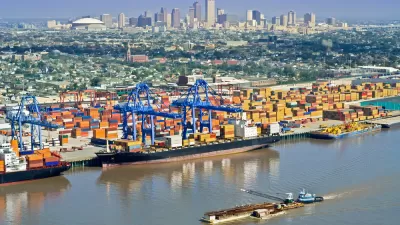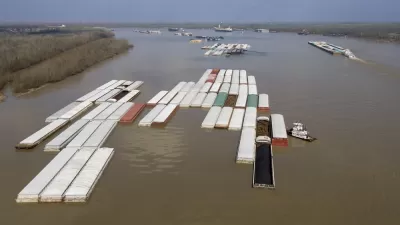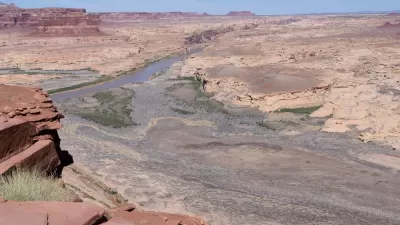The Mississippi River handles $7 billion in trade as one of the world's largest navigable inland waterways. A Midwestern drought has brought the river to water levels so low that they threaten to shut down shipping, reports John Schwartz.
"It would cripple our national economy to shut down the Mississippi River," said R.D. James, a Missouri farmer and a member of the Mississippi River Commission. Those involved in the shipping business have requested the federal government to destroy rock formations that hinder navigation in shallow water and to release water from reservoirs along the upper Missouri River. The Army Corps of Engineers has already been breaking down the formations and expect the work to be completed in 30-45 days. However, the corps has refused the second request, "saying it does not have the authority to use that water to aid navigation on the Mississippi."
Water levels have been dipping more slowly than expected, even though the Waterways Council initially warned that shipping would come to a halt by Monday. The corps estimates that water levels will dip below nine feet by January 11, and unless there is substantial rainfall or the release of water, shipping will come to a stop. "A coalition of businesses involved in trade along the Mississippi and sympathetic lawmakers have asked President Obama to order the water released," says Schwartz, "But without action from the president, Congress or the courts, the water will stay behind the reservoirs of the upper Missouri."
Carriers have been loading barges to a lighter weight to navigate the water depth, but the water crisis may force farmers to consider other transportation options. However, "[w]ith the threat of a shutdown ahead, farmers might decide to hold their grain instead of shipping it in a more expensive manner," said Gregory L. Guenther, a farmer and corporate consultant. Shifting transportation modes would be a short-term solution, but Steven L. Stockton, the director of civil works for the corps, said, "The only long-term solution is more rain."
FULL STORY: Cargo Continues Moving on the Mississippi River, but Perhaps Not for Long

Maui's Vacation Rental Debate Turns Ugly
Verbal attacks, misinformation campaigns and fistfights plague a high-stakes debate to convert thousands of vacation rentals into long-term housing.

Planetizen Federal Action Tracker
A weekly monitor of how Trump’s orders and actions are impacting planners and planning in America.

In Urban Planning, AI Prompting Could be the New Design Thinking
Creativity has long been key to great urban design. What if we see AI as our new creative partner?

Cal Fire Chatbot Fails to Answer Basic Questions
An AI chatbot designed to provide information about wildfires can’t answer questions about evacuation orders, among other problems.

What Happens if Trump Kills Section 8?
The Trump admin aims to slash federal rental aid by nearly half and shift distribution to states. Experts warn this could spike homelessness and destabilize communities nationwide.

Sean Duffy Targets Rainbow Crosswalks in Road Safety Efforts
Despite evidence that colorful crosswalks actually improve intersection safety — and the lack of almost any crosswalks at all on the nation’s most dangerous arterial roads — U.S. Transportation Secretary Duffy is calling on states to remove them.
Urban Design for Planners 1: Software Tools
This six-course series explores essential urban design concepts using open source software and equips planners with the tools they need to participate fully in the urban design process.
Planning for Universal Design
Learn the tools for implementing Universal Design in planning regulations.
Appalachian Highlands Housing Partners
Gallatin County Department of Planning & Community Development
Heyer Gruel & Associates PA
Mpact (founded as Rail~Volution)
City of Camden Redevelopment Agency
City of Astoria
City of Portland
City of Laramie





























